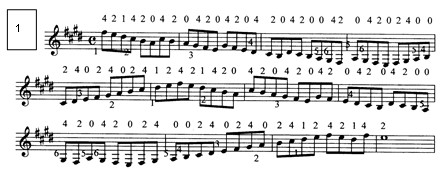SIMPLE TREMOLO EXAMPLE

EXAMPLE - 2 PASSES
|
|
Let's start with tremolo. Using your good picking techniques that you've now made second nature,
start practicing your tremolo on each open string. As always, start
slowly enough so that you are playing cleanly, without hitting any of
the neighboring strings. Make sure also that you are not playing
softer than usual. Play as hard as you normally do, and adjust your
speed accordingly so that you are playing cleanly.
Of course, when performing, you will adjust your volume and intensity
as the piece or your preference calls for. Here we are just
practicing, and you want to have the ability to play with power, even
if that won't be your preference while performing.
Practice this on all the open strings, for as long as you can without
getting too sore. TAKE MANY BREAKS TO LET YOUR WRIST REST. As your
skill progresses and you find yourself more at ease with tremolo (you
will, just be patient) start practicing on fingered notes. These are
usually a little harder because the string length is made shorter, and
therefore a little stiffer.
Start first just one note at a time, then practice moving up and down
scales with the tremolo continuously. As always, start slowly, making
sure you are playing cleanly and accurately.
With this and any exercise like it, if it becomes too boring doing on
its own, do it as you watch TV or listen to music. Just make sure
you're getting it done. Your future of enjoying the oud will be much
richer if you do.
SIMPLE TREMOLO EXAMPLE |
|
Another exercise involving tremolo is to hold the treble D string in
tremolo as you 'bounce' from it to other strings. This was a favorite
technique of
Farid el Atrache and you should listen to his playing often to
pick up on this beautiful technique.
Let's try it with D major. Again, start slowly, making sure to play
everything cleanly, and start holding the D string in tremolo.
Now bounce to C# once as you continue to hold D in tremolo. There
will be a break in the sound of course, but as you progress this break
will become less and less perceptible to your audience.
Now work on bouncing to all the notes on the second (A) string as you
hold D in tremolo. As you become more comfortable, work your way to
bouncing to other strings, as far as you can go.
This is an exercise that should be used throughout your playing days,
not only to improve your playing, but to maintain it as you progress.
REMEMBER, TAKE BREAKS. If your hand falls off, it's a bad thing.
|
|
There is something tricky about playing some note combinations from
one string to another. The only way to correct this is to ATTACK IT!
Here are some exercises that address this issue:
EXAMPLE - 2 PASSES
This exercise helps get your wrist used to playing sometimes tricky
combinations between strings. It also gives your left hand a workout,
but the main focus is on the right. Mix and match with various scales
and makam to work on your left hand too. As always, start slowly and
work your way up to as fast as you can.
|
|
This next one is not worth writing out. I'll record it for you. It
is a chromatic exercise that is tough for both hands after a while.
You start with your little finger (4) on F# on the D string and work
your way down chromatically to the bass E string, and back up again,
over and over.
Play it slowly and cleanly and work your way up in speed over time.
This is a good warm up exercise.
|
|
NEW ADDITION: A section from Şerif Muhiddin Targan's 'Kapris' This is in my opinion the most difficult part of a very complex and I'd say perfect composition. If you can play this part of the 'Kapris' at it's normal speed, then you can play the whole composition. Here I'm playing it very slowly when compared to how S. M. Targan and others have played it. But that's the point, to get the hang of the note patterns with both hands, and then gradually speed it up. I have the written score here (in my Turkish tuning of E A B e a d) written in the key of A (concert pitch). Please note that this score does not represent the original sheet music of the composition, but is simply a 'slowed-down' and slightly altered example of the real thing. The original is in 2/4 time where the notes of this section are written as sixteenth note sextuplets, and I've removed a part of this section to simplify the exercise. Contact me if you would like the actual score.
|
|
Here are the audio examples of this section of Targan's 'Kapris': |
|
Below is the transposed score of the 'Kapris' for Arabic oud in the key of G minor, written in concert pitch. To play the 'Kapris' on your Arabic oud, the tuning from low to high should be: D G A d g c.
|
Remember that you're not trying to hurt your hands, and there is no competition with anyone but yourself. Take your playing as far as you want to, but don't turn this into an unpleasant experience.
Copyright © Mavrothi T. Kontanis. All rights reserved 2008